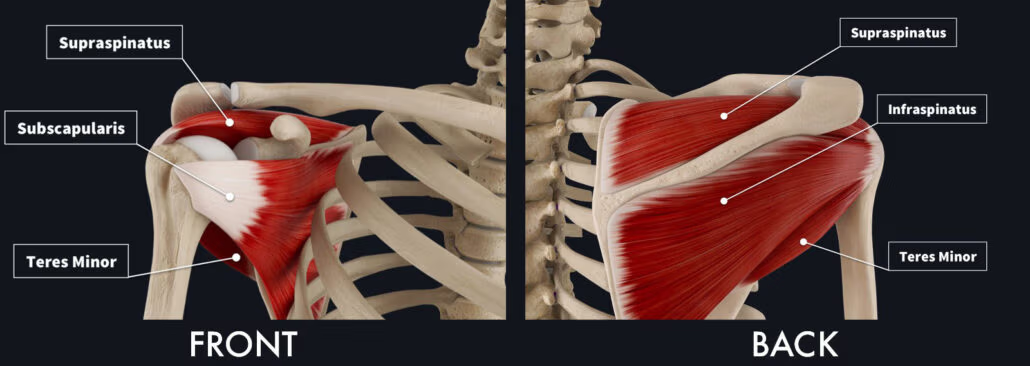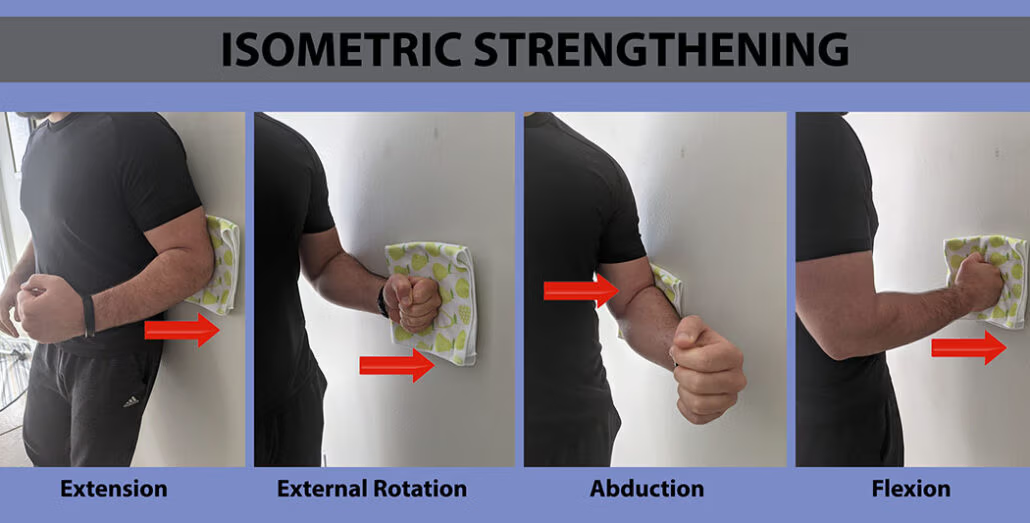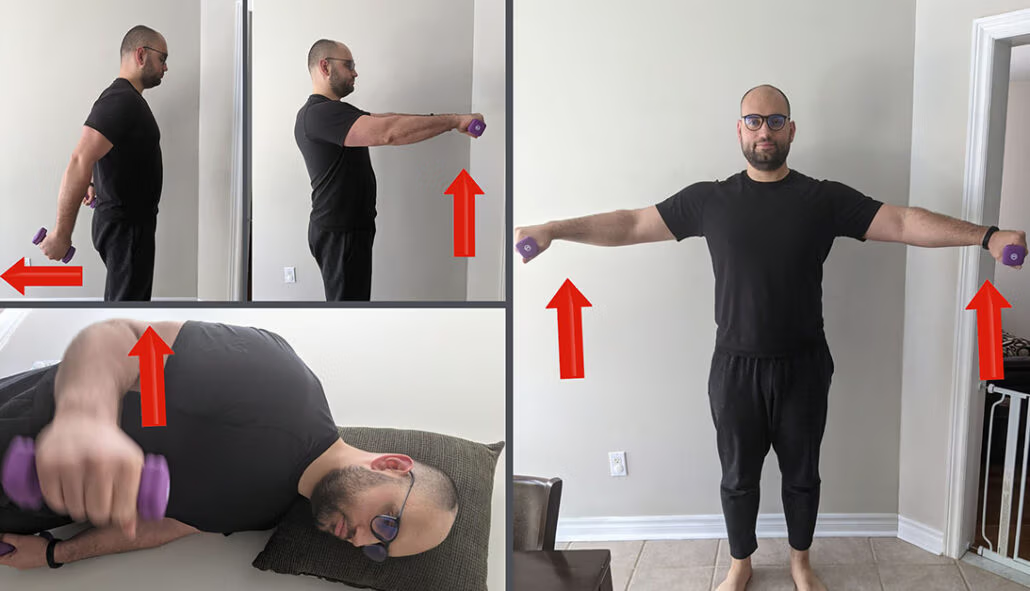When your shoulder aches everything sucks about it, period. If you’ve had some form of shoulder pain or weakness, you know what I’m talking about. We quickly appreciate how much our shoulders contribute to everything we do! Work at a desk? Need them. Work with your hands? Need them too. Drive a vehicle? You even need them for that too.
Long story short, a lot can go wrong with the shoulders when left unchecked. This is why your rotator cuff physiotherapy needs to be super effective. What is the rotator cuff you ask? Let’s talk about that first before we break down how to fix it using a program your shoulders are practically begging for. Yes, I can hear them yelling at you.

ROTATOR CUFF PHYSIOTHERAPY & ANATOMY SIMPLIFIED
The diagram above illustrates each side of your rotator cuff. They’re a group of 4 muscles originating directly from the front and back of your shoulder blades. Each extends out and attaches to the arm bone, aka the humerus. For a while, we thought of them as muscles that function strictly to rotate our shoulders inwards and outwards. While this is true, they have arguably a much more important role in stabilizing our shoulders.
In other words, they reinforce our arm bone into our shoulder socket so we don’t drop our arm when we decide to throw something. I’m not even joking either. Many shoulder dislocations we hear about can be prevented with adherence to a solid rotator cuff physiotherapy program! Next, we’ll talk about the first thing you must consider in your program before you try anything else.

IS THERE ENOUGH MOVEMENT YET IN YOUR SHOULDER?
Your shoulder may be painful or stiff to the point that you can’t fully move it yet. And that’s not cool because in order to even begin gaining strength, you have to be able to move. Just imagine trying to do a bicep curl without the ability to straighten your elbow. Seems counterintuitive right? Same thing applies to your rotator cuff physiotherapy program.
So to check, a simple test is to compare the movement of your affected shoulder to your “normal” shoulder. In the above diagram, we compare the fundamentally important movements such as shoulder flexion, extension, abduction, and external rotation. If the right shoulder equals your left and it’s relatively pain-free, move on to the next step below.

LET’S BUILD SOME POWER IN THESE SHOULDERS
If you can move your shoulder throughout its entire natural range, you might think you’re good to go. However, that couldn’t be further from the truth. In fact, weakness is typically what leads to many of the problems our shoulders must face. Physical therapy for rotator cuff isn’t complete without a carefully planned strengthening protocol.
An important thing to note is the type of pain to expect. When strengthening, you should feel a muscle fatigue type of pain that you’d expect from working your muscles. If you begin feeling any sharp and unexpected pains, you’re likely pushing it too far and will need to adjust accordingly. The strengthening process is as follows:
Isometrics: First, we begin with isometrics for your rotator cuff physio (see diagram above). The goal of isometrics is to contract your muscles without moving your arm. This makes it the easiest way to start strengthening your shoulders. Simply find a towel that you can rest along the wall, and push into it as hard as you comfortably can for a count of 10 seconds. Relax and repeat for 10 repetitions. Strengthen all the above movements to get ready for the next phases of strengthening.

Concentric: Once you’re comfortable with isometrics, the next step to strengthen your shoulder concentrically, i.e. with movement. This can be done with dumbbells, resistance bands, and even soup cans. The objective is to build integrity around your rotator cuff to get it ready for use in the real world. You want to strengthen all the fundamental movements that we initially needed to free up. Using the above diagram as a guide, try a repetition range of 15 with a controlled pace for each exercise.
Be sure not to rest the weight on your side in between reps. Complete 3 sets of each exercise, and aim to do this at least 3-4 times a week initially. To implement eccentrics for your shoulder, consider the same diagram we used for concentric exercises. The one variable you’ll change is the time you take to lower the weight on each rep. Try using a time system. If it takes 2 seconds to lift the weight up, spend 4 seconds (or more) lowering the weight. You’ll find that this will make the movements tougher which is practically the point.
Eccentrics: Physical therapy for rotator cuff wouldn’t be complete without including eccentrics. Just like concentric exercises, eccentrics also strengthen the muscles with movement. The difference is that the muscle is actually getting longer as you contract it. Seems counterintuitive right?
Think of it this way. If you’re doing a heavy bench press and you want to lower the weight, would you let it drop on your chest and run the risk of decapitating yourself? I hope the answer is no. Instead, you’d control how fast you lower the bar until it gets close enough to your chest to push it back up. This is eccentric loading in a nutshell.

EVENTUALLY, YOU NEED TO PLAN FOR RETURN TO WORK/ACTIVITY
It’s all peachy and dandy that you can do all the above. But what do your daily activities require out of your shoulders? Say for example you play a throwing sport like baseball. You may want to consider more complex strengthening movements that mimic winding up and throwing a ball. Work as a mechanic? Perhaps you should work on your overhead strength using strengthening movements like overhead presses. These are all things that require a rotator cuff physiotherapy assessment to tease out necessary requirements at this stage.
OTHER THINGS TO CONSIDER FOR ROTATOR CUFF PHYSIOTHERAPY
Other things to note are whether you’re completing physical therapy for rotator cuff surgery versus an isolated injury or repetitive strain. These three unique situations require a bit of their own tweaking to ensure optimal results. Of course, for a detailed plan for your rotator cuff physio, always make sure to visit a professional like a physiotherapist! Have any questions? Feel free to email us at: [email protected]
Ready to book an appointment? Click here to secure an assessment!

